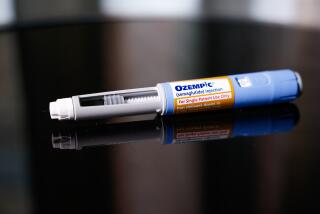Do diet patch claims stick?
- Share via
If every “miracle” weight-loss product really did the job, people everywhere would be cinching up their belts, gyms would become eerily quiet and TV stations would soon run out of B-roll footage of big bellies at the mall.
Clearly, some weight-loss products fall short of their claims. But how can you spot the scams? The Federal Trade Commission has some basic guidelines: Don’t trust any product that claims to work for everyone or anything that supposedly helps you lose more than 2 pounds in a week. According to the FTC, you also shouldn’t count on any weight-loss product that you put on the skin, including all diet patches.
But perhaps the FTC was too hasty. “To be fair, you have to look at everything on a case-by-case basis,” says Gary Foster, director of the Center for Obesity Research and Education at Temple University in Philadelphia. There’s no reason why an effective diet remedy could never be delivered through the skin, he says, so the concept shouldn’t be dismissed out of hand.
The Ezee Slimming Patch, sold online and at many health food stores, contains 25 milligrams of bladderwrack kelp (Fucus vesculosis) along with mangosteen fruit (Garcinia cambogia) and menthol. Users are instructed to “wear the patch with pride where everyone can see it.” The site also encourages users to cut down on their daily food intake by about one-third. A pack of 15 patches costs about $25.
The ingredient list for the Pink Patch, sold online, includes bladderwrack, yerba mate (Ilex paraguariensis) and 5-HTP, an amino acid sometimes touted as an appetite suppressant. The Pink Patch website, which is squarely targeted at teenage girls, tells users to put on a fresh patch every morning. The site sells a pack of 30 patches (the Glamour Girl Pack) for about $50.
Be-Slim, a patch advertised on TV and sold online, contains, among other things, bladderwrack, 5-HTP and L-carnitine, a natural compound that helps shuttle fat into the powerhouses -- mitochondria -- of cells, where fats are metabolized. Users are instructed to replace the patch every 24 hours. A pack of 30 sells online for about $30.
The claims
The label for the Ezee Slimming patch says it “stops cravings for sweets and junk foods.” The product website calls it “the only natural and honest approach to lose weight permanently.” Nick Jerch, owner of Bell Lifestyle Products Inc.,the Canada-based company behind Ezee Slimming, says that users can safely lose up to 5 pounds in a month. Even more weight loss is possible, he says, but he doesn’t recommend it.
The website for the Pink Patch has this message for young girls: “Don’t give up your social life and become a slave to the gym to achieve that perfect body. Simply put on the Pink Patch -- it’s that easy!” The site also says “You WILL have the hottest body and the dream life.” Users are told to expect weight loss of 1 to 3 pounds each week.
The Be-Slim site claims the patch will boost metabolism and blunt appetite so that users will “enjoy a healthier figure” and “feel more energetic than ever before.”
The bottom line
Some day, scientists might develop an effective weight-loss patch, says Dr. Howard Eisenson, executive director of the Duke Diet and Fitness Center in Durham, N.C. But, to his mind, that day is probably still far off. The patches on the market today “are beyond ridiculous,” he says. “The more hyperbolic the claims, the more people can quickly dismiss the product.”
Eisenson says there’s no evidence that bladderwrack, a common ingredient in weight loss patches, can encourage weight loss or suppress appetite. The seaweed hasn’t been thoroughly tested orally, let alone through the skin, he says.
So far, no diet patch has passed muster in a published, peer-reviewed study, says Dr. Michael Steelman, past president of the American Society of Bariatric Physicians. A study of the Pink Patch posted on the website www.independentdietstudy.com supposedly found that women who tried the patch lost an average of 6.1 pounds in four weeks. But Steelman calls the results “suspicious” and “not at all convincing.”
For one thing, the study was small -- it included only 12 women -- and has never been published in a journal. The report also seemed to fail at basic math. A table says that the women using the patch lost 2.9 pounds in the first week and 2.1 pounds for each of the next three weeks. If true, that would add up to a weight loss of 9.2 pounds, not 6.1 pounds.
Foster says that good weight-loss studies are relatively simple and inexpensive, and there’s really no reason why they shouldn’t be conducted to back up strong claims. “If you had a successful product, you’d be rushing to put people on a scale,” Foster says.
Red flags should go up whenever a product promises to speed weight loss by boosting metabolism or reducing appetite, Foster adds. No compound known to science can increase metabolism enough to really budge the scale, he says, and every known appetite suppressant has significant side effects. Some stimulants, for example, will curb hunger but will also make the heart race.
Neither Curb Your Cravings, the company behind the Pink Patch, or Verseo Inc. of New York, makers of Be-Slim, responded to requests for comment. Nick Jerch, the owner of the company behind the Ezee Slimming Patch, says his company has received many testimonials from satisfied customers. But even he admits that a patch alone can’t win the weight war.
“Many companies make claims that they can’t support,” he says. “You have to change your eating habits to really lose weight.”
Curious about a consumer health product? Send an e-mail to health@latimes.com. Read more at latimes.com/skeptic.






